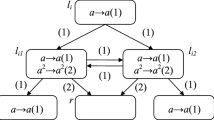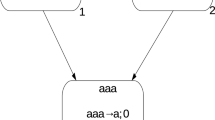Abstract
Dynamic threshold neural P systems (DTNP systems, for short) are a kind of distributed parallel computing systems abstracted from the spiking and dynamic threshold mechanisms of neurons. A DTNP system consists of several dynamic threshold neurons, and each neuron has a data unit and a threshold unit. The computational completeness of DTNP systems has been investigated. DTNP systems are synchronous systems, and a global clock is assumed to synchronize all threshold neurons. However, the assumption is biologically non-realistic. In this paper, we discuss DTNP systems working in sequential mode, i.e., sequential DTNP systems (SDTNP systems, in short). Based on the number of spikes of active neurons and the rule-application strategy, four sequentiality strategies are considered. It is proven that SDTP systems working in four sequentiality strategies are Turing universal number generating/accepting devices.










Similar content being viewed by others
References
Pǎun, G. (2000). Computing with membranes. Journal of Computer System Sciences, 61(1), 108–143.
Pǎun, G., Rozenberg, G., & Salomaa, A. (2010). The oxford handbook of membrane computing. New York: Oxford University Press.
Martin-Vide, C., Pazos, J., Pǎun, G., & Rodríguez-Patón, A. (2003). Tissue P systems. Theoretical Computer Science, 296(2), 295–326.
Freund, R., Pǎun, G., & Pérez-Jiménez, M. J. (2005). Tissue-like P systems with channel-states. Theoretical Computer Science, 330(1), 101–116.
Pǎun, G., & Pérez-Jiménez, M. J. (2010). Solving problems in a distributed way in membrane computing: DP systems. International Journal of Computers Communications & Control, 5(2), 238–250.
Valencia-Cabrera, L., Orellana-Martín, D., Martínez-Del-Amor, M. A., et al. (2017). Computational efficiency of minimal cooperation and distribution in polarizationless P systems with active membranes. Fundamenta Informaticae, 153(1–2), 147–172.
Song, B., & Pan, L. (2016). The computational power of tissue-like P systems with promoters. Theoretical Computer Science, 641, 43–52.
Ciencialová, L., Csuhaj-Varjú, E., Kelemenová, A., & Vaszil, G. (2009). Variants of P colonies with very simple cell structure. International Journal of Computers Communications & Control, 4(3), 224–233.
Zhang, X., Liu, Y., Luo, B., & Pan, L. (2014). Computational power of tissue P systems for generating control languages. Information Sciences, 278(10), 285–297.
Peng, H., Wang, J., Pérez-Jiménez, M. J., & Riscos-Núñez, A. (2015). An unsupervised learning algorithm for membrane computing. Information Sciences, 304(20), 80–91.
Peng, H., Wang, J., Shi, P., Pérez-Jiménez, M. J., & Riscos-Núñez, A. (2016). An extended membrane system with active membranes to solve automatic fuzzy clustering problems. International Journal of Neural Systems, 26(3), 1650004–1-17.
Peng, H., Shi, P., Wang, J., Riscos-Núñez, A., & Pérez-Jiménez, M. J. (2017). Multiobjective fuzzy clustering approach based on tissue-like membrane systems. Knowledge-Based Systems, 125, 74–82.
Ionescu, M., Pǎun, G., & Yokomori, T. (2006). Spiking neural P systems. Fundamenta Informaticae, 71, 279–308.
Pǎun, G. (2007). Spiking neural P systems with astrocyte-like control. Journal of Universal Computer Science, 13(11), 1707–1721.
Pan, L., Wang, J., & Hoogeboom, H. J. (2012). Spiking neural P systems with astrocytes. Neural Computation, 24(3), 805–825.
Pan, L., & Pǎun, G. (2009). Spiking neural P systems with anti-spikes. International Journal of Computers Communications & Control, 4(3), 273–282.
Song, T., Pan, L., & Pǎun, G. (2014). Spiking neural P systems with rules on synapses. Theoretical Computer Science, 529, 82–95.
Song, T., & Pan, L. (2015). Spiking neural P systems with rules on synapses working in maximum spiking strategy. IEEE Transactions on Nanobioscience, 14(4), 465–477.
Peng, H., Chen, R., Wang, J., Song, X., Wang, T., Yang, F., et al. (2017). Competitive spiking neural P systems with rules on synapses. IEEE Transactions on NanoBioscience, 16(8), 888–895.
Song, T., & Pan, L. (2016). Spiking neural P systems with request rules. Neurocomputing, 193, 193–200.
Cabarle, F. G. C., Adorna, H. N., Pérenz-Jiménez, M. J., & Song, T. (2015). Spiking neural P systems with structural plasticity. Neural Computing and Applications, 26(8), 1905–1917.
Wu, T., Pǎun, A., Zhang, Z., & Pan, L. (2017). Spiking neural P systems with polarizations. IEEE Transactions on Neural Networks and Learning Systems, 29(8), 3349–3360.
Pan, L., Pǎun, G., Zhang, G., & Neri, F. (2017). Spiking neural P systems with communication on request. International Journal of Neural Systems, 27(8), 1750042–1-13.
Peng, H., Yang, J., Wang, J., Wang, T., Sun, Z., Song, X., et al. (2017). Spiking neural P systems with multiple channels. Neural Networks, 95, 66–71.
Lv, Z., Bao, T., Zhou, N., Peng, H., Huang, X., Riscos-Núñez, A., et al. (2020). Spiking neural p systems with extended channel rules. International Journal of Neural Systems,. https://doi.org/10.1142/S0129065720500495.
Peng, H., & Wang, J. (2019). Coupled neural P systems. IEEE Transactions on Neural Networks and Learning Systems, 30(6), 1672–1682.
Peng, H., Li, B., Wang, J., Song, X., Wang, T., Valencia-Cabrera, L., et al. (2020). Spiking neural P systems with inhibitory rules. Knowledge-Based Systems, 188(105064), 1–17.
Peng, H., Lv, Z., Li, B., Luo, X., Wang, J., Song, X., et al. (2020). Nonlinear spiking neural P systems. International Journal of Neural Systems,. https://doi.org/10.1142/S0129065720500082.
Peng, H., Bao, T., Luo, X., Wang, J., Song, X., Riscos-Núñez, A., et al. (2020). Dendrite P systems. Neural Networks, 127, 110–120.
Peng, H., Wang, J., Pérez-Jiménez, M. J., Wang, H., Shao, J., & Wang, T. (2013). Fuzzy reasoning spiking neural P system for fault diagnosis. Information Sciences, 235(20), 106–116.
Wang, J., Shi, P., Peng, H., Pérez-Jiménez, M. J., & Wang, T. (2013). Weighted fuzzy spiking neural P systems. IEEE Transactions on Fuzzy Systems, 21(2), 209–220.
Zhang, G., Rong, H., Neri, F., & Pérez-Jiménez, M. J. (2014). An optimization spiking neural P system for approximately solving combinatorial optimization problems. International Journal of Neural Systems, 24(5), 1440006–1-16.
Wang, T., Zhang, G., Zhao, J., He, Z., Wang, J., & Pérez-Jiménez, M. J. (2015). Fault diagnosis of electric power systems based on fuzzy reasoning spiking neural P systems. IEEE Transactions on Power Systems, 30(3), 1182–1194.
Peng, H., Wang, J., Shi, P., Pérez-Jiménez, M. J., & Riscos-Núñez, A. (2017). Fault diagnosis of power systems using fuzzy tissue-like P systems. Integrated Computer-Aided Engineering, 24(4), 401–411.
Peng, H., Wang, J., Ming, J., Shi, P., Pérez-Jiménez, M. J., Yu, W., et al. (2018). Fault diagnosis of power systems using intuitionistic fuzzy spiking neural P systems. IEEE Transactions on Smart Grid, 9(5), 4777–4784.
Wang, J., Peng, H., Yu, W., Ming, J., Pérez-Jiménez, M. J., Tao, C., et al. (2019). Interval-valued fuzzy spiking neural P systems for fault diagnosis of power transmission networks. Engineering Applications of Artificial Intelligence, 82, 102–109.
Díaz-Pernil, D., Peña-Cantillana, F., & Gutiérrez-Naranjo, M. A. (2013). A parallel algorithm for skeletonizing images by using spiking neural P systems. Neurocomputing, 115, 81–91.
Díaz-Pernil, D., Gutiérrez-Naranjo, M. A., & Peng, H. (2019). Membrane computing and image processing: a short survey. Journal of Membrane Computing, 1, 58–73.
Li, B., Peng, H., Wang, J., & Huang, X. (2020). Multi-focus image fusion based on dynamic threshold neural P systems and surfacelet transform. Knowledge-Based Systems, 196(105794), 1–12.
Li, B., Peng, H., Luo, X., Wang, J., Song, X., Pérez-Jiménez, M. J., et al. (2020). Medical image fusion method based on coupled neural p systems in nonsubsampled shearlet transform domain. International Journal of Neural Systems,. https://doi.org/10.1142/S0129065720500501.
Cavaliere, M., Ibarra, O. H., Pǎun, G., Ecegioglu, O., Ionescu, M., & Woodworth, S. (2009). Asynchronous spiking neural P systems. Theoretical Computer Science, 410(24), 2352–2364.
Song, T., Zou, Q., Liu, X., & Zeng, X. (2015). Asynchronous spiking neural P systems with rules on synapses. Neurocomputing, 151(3), 1439–1445.
Cabarle, F. G. C., Adorna, H. N., & Pérez-Jiménez, M. J. (2015). Asynchronous spiking neural P systems with structural plasticity. In International conference on unconventional computation and natural computation. Lecture notes in computer science (Vol. 9252, pp. 132–143).
Ibarra, O. H., Pǎun, A., & Rodríguez-Patón, A. (2009). Sequential SNP systems based on min/max spike number. Theoretical Computer Science, 410, 2982–2991.
Zhang, X., Luo, B., Fang, X., & Pan, L. (2012). Sequential spiking neural P systems with exhaustive use of rules. BioSystems, 108, 52–62.
Song, T., Pan, L., Jiang, K., Song, B., & Chen, W. (2013). Normal forms for some classes of sequential spiking neural P systems. IEEE Transactions on Nanobioscience, 12(3), 255–264.
Jiang, K., Song, T., & Pan, L. (2013). Universality of sequential spiking neural P systems based on minimum spik number. Theoretical Computer Science, 499, 88–97.
Cabarle, F. G. C., Adorna, H. N., & Pérez-Jiménez, M. J. (2016). Sequential Spiking neural P systems with structural plasticity based on max/min spike number. Neural Computing and Applications, 27(5), 1337–1347.
Zhang, X., Zeng, X., Luo, B., & Pan, L. (2014). On some classes of sequential spiking neural P systems. Neural Computation, 26(5), 974–997.
Bibi, A., Xu, F., Adorna, H. N., & Cabarle, F. G. C. (2019). Sequential spiking neural P systems with local scheduled synapses without delay. Complexity, Paper id 7313414, 1–12.
Peng, H., Wang, J., Pérenz-Jiménez, M. J., & Riscos-Núñez, A. (2019). Dynamic threshold neural P systems. Knowledge-Based Systems, 163, 875–884.
Korec, I. (1996). Small universal register machines. Theoretical Computer Science, 168(2), 267–301.
Acknowledgements
This work was partially supported by the National Natural Science Foundation of China (No. 62076206), and Research Foundation of the Education Department of Sichuan province (No. 17TD0034), China.
Author information
Authors and Affiliations
Corresponding author
Ethics declarations
Conflict of interest
The authors declare that they have no conflict of interest.
Additional information
Publisher's Note
Springer Nature remains neutral with regard to jurisdictional claims in published maps and institutional affiliations.
Rights and permissions
About this article
Cite this article
Bao, T., Zhou, N., Lv, Z. et al. Sequential dynamic threshold neural P systems. J Membr Comput 2, 255–268 (2020). https://doi.org/10.1007/s41965-020-00060-0
Received:
Accepted:
Published:
Issue Date:
DOI: https://doi.org/10.1007/s41965-020-00060-0




